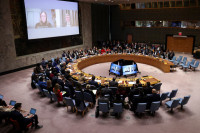Opinion
Shining light
Last week, an editorial of a leading newspaper devoted its column to the Nepali Congress, the country’s largest democratic party.
Sarin Ghimire
Last week, an editorial of a leading newspaper devoted its column to the Nepali Congress, the country’s largest democratic party. It mentioned how the current party leadership has lost its direction in terms of running both the party and the government. It was quick to question if Prime Minister Sher Bahadur Deuba, also NC’s president, was a capable leader. The editorial highlighted the shortcomings of Deuba’s leadership, as shown by the fact that NC dropped to second position in the two rounds of local elections, and that the government took too long to expand the Cabinet.
However, without understanding the machinations of various interest groups, the structure of the party, the dynamics of the coalition government and its primary objectives, it would be premature to come to such conclusions.
Analysing decisions
International political economists consider three ‘I’s that play a crucial role in deriving policy choices—interests, institutions and information. A similar analysis could be made of the NC’s decision-making process. With an institutionalised form of factionalism ever since the mother party unified with its splinter group roughly a decade ago, the NC functions more along the lines of leader-based partisan grouping as opposed to ideology. Instead of the traditional form of electing leaders from the grassroots level, the NC uses a top-down approach, where a handful of top leaders call the shots with the backing of their respective factions.
Deuba has little choice but to give in to the demands of the various sub-groups in his party, either in terms of picking ministers, giving the party and its sister organisations full shape, or picking election candidates. A senior party leader, under condition of anonymity, went so far as to say that the leadership was compelled to field candidates deemed weak in certain areas just to please other factions. During the recent local elections, candidates from one group were hardly supported by the rival groups. The severity of internal factionalism was also evident when the NC was dwelling on choosing election candidates until the 11th hour, when other parties had already begun their election campaigning. Media reports also suggested that the NC factions were internally bargaining to secure plum ministries and threatening to boycott the Cabinet if their demands were not met.
The structure of the legislature may be another factor in slowing down Deuba’s decision-making process. The constitution envisages a form of government where the executive head of the country is not directly elected by the people but by Members of Parliament. This means that the government is usually formed by a coalition of several parties, unless one party wins a clear majority of seats in parliamentary elections. Given the large number of parties in the country and the proportional representation system, winning a majority during elections is unlikely. A higher number of coalition partners correlates to more compromises that the leading party has to make to retain its majority position. For example, the current coalition is comprised of three major parties—the NC, the Maoist Centre and the Madhesi Janadhikar Forum (Loktantrik)—with the Rastriya Prajatantra Party (RPP) also playing a crucial role. All of these parties want representation in the Cabinet. Bringing the RPP on board was deemed important to increase the chances of passing the constitutional amendment bill by the required two-thirds majority. The Rastriya Janata Party-Nepal (RJP-N) wants the amendment before agreeing to participate in the polls. In the end, the PM and the RPP were said to be at odds in a power-sharing deal, leading the RPP, the fourth largest party, to opt out of the government. The Maoist Centre, too, has managed to acquire portfolios disproportionate to their number of seats in Parliament. Working within a fragile coalition is fraught with complications.
Premature decision
This brings us to perhaps the most important reason why the NC lost its spot as the largest party in the recent elections. The NC has adequately explained some of its controversial decisions, such as the IGP appointment saga, impeachment motion against the then chief justice Sushila Karki, ambassadorial nominations and alignment with the Maoists in certain districts during the local polls.
Why did the NC fail to explain its decisions, even as the CPN-UML made political hay out of them by publicising them as NC’s shortcomings? Perhaps it was the structure of the two political organisations that made a difference. A mass-based democratic party, the NC allows its well-wishers to deliberate on decisions made by the leadership, with many of them criticising such choices openly. By contrast, the CPN-UML is strictly a cadre-based communist party that flourishes on top-down discipline. The CPN-UML cadres are rarely seen criticising their party’s decisions. The NC also failed to cogently explain its idea of “inclusive nationalism” while garnering support for constitution amendment, whereas as the CPN-UML promoted its image of being an ultra-nationalistic force by stirring hill sentiments.
That Deuba cannot handle his party and the government may be a premature decision. But if the NC continues to fall prey to deeply rooted internal partisan politics and is sluggish in defending its decisions, we could very well see the oldest force in the country falling second behind the CPN-UML in the upcoming provincial and federal elections too.
Ghimire is pursuing an MSc in International Political Economy at the S Rajaratnam School of International Studies, Singapore




 5.15°C Kathmandu
5.15°C Kathmandu












